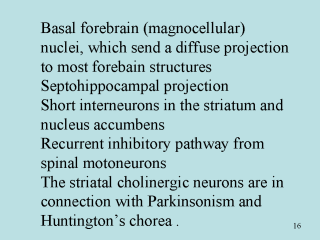| front |1 |2 |3 |4 |5 |6 |7 |8 |9 |10 |11 |12 |13 |14 |15 |16 |17 |18 |19 |20 |21 |22 |23 |24 |25 |26 |27 |28 |review |
 |
ACETYLCHOLINE
RECEPTORS Ach has mainly excitatory effects, which are mediated by various subtypes of either nicotinic (N-R, ligand-gated channels) or muscarinic (M-R, G-protein-coupled) receptors. Some M-Rs are inhibitory. The M-R in the brain are predominantly of M1 type. They act presynaptically to inhibit Ach release from cholinergic neurons, and M-antagonist, by blocking this inhibition, markedly increase Ach release. Many of behavioral effects associated with cholinergic pathways seem to be produced by Ach acting on M-Rs. N-Rs are also widespread in the brain, but much sparser than M-Rs, there are many subtypes of these Rs. Mostly, these Rs appear to be located presynaptically and to facilitate the release of other transmitters, such as glutamate and DA. FUNCTIONAL ASPECTS M-R appear to mediate the main behavioral affects associated with Ach, namely effects on arousal, learning and short memory. |